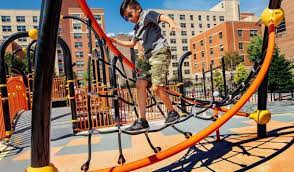It is more crucial than ever to create outdoor spaces where kids can play, explore, and get in touch with nature in today’s tech-savvy world. Children’s play areas should be designed with safety, usability, and most importantly, enjoyment in mind. We’ll go over important guidelines and concepts in this blog post to help you design fun and safe outdoor play spaces that inspire kids to enjoy nature.
- Safety First: Select Materials Safe for Children
Safety is the cornerstone of any kid-friendly outdoor play space. Start by choosing materials that are long-lasting, low maintenance, and non-toxic. Steer clear of materials that could choking hazard, sharp edges, and splinters. Some materials that are suitable for children are as follows:
- Synthetic turf or rubber can provide cushioned and supple play surfaces.
- Low-VOC, non-toxic paint for play equipment and painted structures.
- Round, smooth wooden features that have been treated to fend off insects and rot.
- For fall protection, place rubber mulch or gravel underneath swings and climbing frames.
To avoid mishaps, make sure that all playthings and structures are set up and fastened firmly. It’s essential to perform routine maintenance and inspections to quickly address wear and tear.
- Design Appropriate for Age
Children’s needs and skills vary depending on their age. You should create zones or areas in your landscape design that correspond to the developmental stages of different age groups. As an illustration:
- A separate, fenced play area with kid-friendly swings, short slides, and sensory play features might be beneficial for toddlers.
- Sandboxes, playhouses, and more difficult climbing structures are great for preschoolers.
- Older kids might require open areas for sports, running, and more daring playthings like zip lines or rope courses.
Age-appropriate features help you design for every child, ensuring their experience is both safe and enjoyable.
- Provide Organic Play Components
Including natural elements in your play area can improve the sensory experience and foster a sense of connection between kids and their surroundings. Think about adding attributes such as:
- A pit of sand or dirt to explore and dig in.
- Boulders or other rock formations for role-playing and climbing.
- Water features, like fountains or tiny streams, are great for entertaining the senses and keeping cool during the summer.
- Planting spaces where kids can take care of and grow their own vegetables or flowers.
Incorporating natural play elements not only stimulates children’s imagination but also offers chances for environmental education.
- Coverage and Protection
For the sake of their comfort and safety, children must be shielded from the sun and rain. Include shade structures in the design of your play area, such as pergolas, canopies, or umbrellas. These shady spaces can also be cozy places for caregivers or parents to watch over and unwind.
Provide a covered space for pretend play, such as a playhouse or treehouse, if at all possible. It gives kids a comfortable place to make up their own stories and adventures.
- Inclusivity and Accessibility
Make sure all kids, including those with disabilities, can play in your outdoor space. Make sure the play equipment is inclusive of different abilities and that the pathways are wide enough to accommodate wheelchairs and strollers.
In addition to being physically accessible, inclusivity also involves fostering a warm and accepting atmosphere that allows kids of different backgrounds and skill levels to play together.
- Promote Creative Play
A child’s imagination is a valuable tool for development. Provide environments that inspire children’s imagination and foster creative play. Children can be transported to other worlds where they can live the lives of explorers, pirates, or adventurers by means of features like treehouses, tunnels, or forts.
Give kids loose parts to build, create, and invent their own games and stories, such as sticks, stones, and natural materials.
- Include Playthings
An essential part of any outdoor play area is play equipment. Think about play value, longevity, and safety when selecting equipment. Several well-liked choices consist of:
- Slides and Swings: Age-old favorites that can amuse people for hours.
- Climbing frames: These promote movement and equilibrium.
- Treehouses or Playhouses: Excellent for hiding away and engaging in imaginative play.
- Sand Tables and Play Kitchens: Encourage imagination and sensory play.
Make sure there is adequate room around each piece of play equipment when installing it to avoid crowding and collisions. Any equipment that is used for climbing or swinging should have safety surfacing, such as rubber mulch or mats, underneath it to prevent falls.
- Play in the Water
Playing with water is a great way to keep kids occupied and cool on hot summer days. Think about including splash pads, tiny fountains, or shallow pools with the necessary safety precautions in place.
When kids play with water, adults must supervise them, and water features should be made with safety in mind to avoid mishaps.
- Educational Components
Include instructive components in your play area to encourage learning while having a good time. Features such as these can be added:
- Whiteboards or chalkboards outside for writing and drawing.
- Butterfly gardens or birdhouses can be found in nature observation areas.
- Sculptures or art installations that encourage experimentation and creativity through interaction.
These components inspire kids to investigate, discover, and establish connections with the surrounding natural environment.
- Areas for Gathering and Seating
Creating inviting spaces for relaxation and interaction is essential in family-friendly landscape design. By incorporating features such as play structures with integrated seating, picnic tables, or benches, you can provide opportunities for parents, guardians, and children to unwind and socialize together. These designated areas not only promote bonding but also allow parents to enjoy the outdoors while keeping a watchful eye on their children. Redefine your outdoor space with landscape design that caters to the needs and desires of families, fostering an environment of leisure and togetherness.
In Summary
Carefully planning and taking into account the needs and abilities of children is necessary when creating a safe and enjoyable outdoor play area for them. Putting safety first, adding natural elements, setting up zones according to age, and promoting imaginative play will help you create an environment where kids can grow emotionally, intellectually, and physically. An intentionally planned outdoor play space encourages physical exercise, cultivates a love of the outdoors, and offers chances for socialization and education. In the end, it’s a gift that never ends, enabling kids to explore, develop, and make priceless memories in the vast outdoors. Learn more about us and our commitment to creating vibrant and engaging outdoor play spaces for children of all ages.



